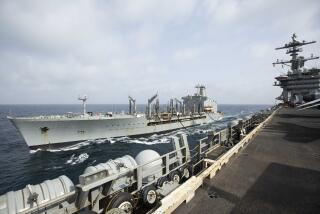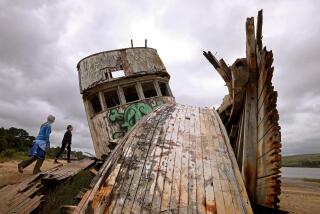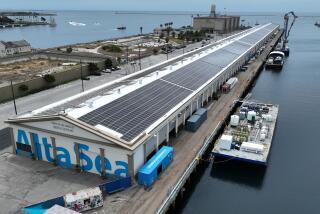Valdez Is Eased Into Dry Dock at Nassco for Repairs, Answers
The Exxon Valdez came out of the water Tuesday and into the dry dock of its birth, where workers and federal investigators will get the first look at the tankerâs shredded hull since it crashed into a reef in Alaska, causing the nationâs worst oil spill.
The vessel, guided by eight tugboats, lasers, hydraulic supports and a high tide that helped it into the dock, will undergo a $25-million, nine-month reconstruction at National Steel & Shipbuilding Co., where it was built in 1986. Hundreds of workers--including 300 newly employed--will patch the ship with more than 3,000 tons of steel.
It will be at least a week, however, before workers can begin the repairs. After all the water is drained from the Valdez, which is expected to take three or four days, investigators from the National Transportation Safety Board, the Coast Guard and the state of Alaska will examine the hull in an attempt to determine what caused 11 million gallons of oil to spill into Prince William Sound last March.
âItâs very deliberate,â said Al Lutter, a senior vice president at Nassco. âYou wonât see any fast moves.â
Waited for High Tide
The Valdez had been sitting at its Nassco berth since July 31, when it entered San Diego Bay after drifting offshore for three weeks. Workers attached hydraulic supports to the ship and prepared the dry dock, then waited for a high tide to float the tanker over the dockâs sill.
The tide arrived about 6:30 p.m. Tuesday, more than an hour after the ship had been towed several hundred yards into the bay, then turned and backed stern-first to the dockâs edge.
As the vessel was being towed, a helicopter overhead reported that a bluish sheen about the width of the ship had been sighted next to the tanker. Pollution-response boats following the tugs tried to skim the water, but the material was not floating on the surface.
Nassco officials were uncertain late Tuesday whether the Valdez was the source of the sheen, or whether samples had been collected. But Carrie Chassin, an Exxon Shipping Co. spokeswoman, said the material was similar to discharges that had come from the ship as it sat off San Diego. Those proved to be algae, she said.
Frank Russell, a docking expert for Nassco, directed the tugs in guiding the 987-foot-long ship into the 1,000-foot-long berth. The 166-foot-wide tanker had less than 2 feet clearance on either side, and was eased in slowly. Lasers were used to help workers determine whether the ship was on course.
âVery Pleased Sheâs Homeâ
After the shipâs bow had cleared the dockâs sill, a tug moved a massive gate into place, and the water level in the dock was lowered to about 14 feet. Hydraulic supports alongside the ship locked the vessel into place and steadied it as it came to rest on blocks shortly before midnight.
âThe Exxon Valdez came smoothly into the graving dock, and weâre very pleased sheâs home,â Fred Hallett, Nasscoâs vice president of finance, said as he watched the final lengths of the ship slip past the sill. Hallett said the dock technically is known as a graving dock--a non-floating, immobile area.
Hallett said most of the water used to flood the dock will be tested and returned to the bay if it is free of pollutants. After Nassco workers wash the walls of the shipâs open tanks with high-pressure cleaning equipment, the remaining dock water, about 23 million gallons and the water in the open tanks will gradually be pumped to another Exxon tanker and shipped to Northern California, where Exxon labs will test it for contaminants, he said.
âThe potential for waxy residue and hazardous materials in the shipâs tanks will be high,â he said.
The Valdez arrived off San Diego on July 10 after being towed 2,200 miles from Alaska, where it hit a reef March 24 and spilled millions of gallons of oil along the pristine shoreline. But its entry into San Diego Bay was delayed by the discovery of steel plates that were jutting from its hull, as well as a 18-mile slick nearby.
Scrutiny Ahead
The plates were eventually removed, and the state and Exxon reached an agreement to allow the ship into state waters.
âAny concerns about the ship have now been laid to rest,â an Exxon spokeswoman said July 31 when the Valdez came to berth at Nassco.
But heavy scrutiny of the tanker may be only beginning. A team of representatives from the National Transportation Safety Board, the state of Alaska, Exxon and Alyeska Pipeline Service Co., a consortium of oil companies that runs the trans-Alaskan pipeline, is expected to arrive soon in San Diego to examine the hull damage.
Once the dock and ship are dry, the team, headed by an NTSB marine accident investigator, will spend several days trying to determine, among other things, how deeply the reef penetrated the hull, the extent of the impact and whether a double bottom on the ship could have lessened the damage to the environment.
The single-hull construction of the tanker has drawn criticism from environmentalists and, more recently, the Coast Guard. In an internal study based on computer simulations and examined by a congressional committee earlier this month, the agency theorized that a double bottom could have prevented as much as 60% of the spill.
However, the report, called âpreliminaryâ by the Coast Guard, also notes that such a design would have been even more vulnerable in a collision with another ship.
No Second Hull
Exxon officials earlier criticized the report as inconclusive and hypothetical, and on Tuesday said repairs at Nassco would not include the addition of a second hull.
Federal agencies said Tuesday that an analysis of the single hullâs effectiveness will follow a fact-finding investigation.
âWe havenât had a chance to measure the extent of damage to the hull. It would really be premature for (investigators) to postulate what could have happened,â said Drucella Andersen, a spokeswoman for the NTSB in Washington.
Andersen said the NTSB, which is also conducting computer simulations, will eventually rule on the probable cause of the accident, make safety recommendations and evaluate the performance of the crew.
In addition, the Coast Guard in San Diego is investigating whether the ship polluted the waters as it sat off California.
Although a Coast Guard official said Monday that the agency had identified at least one violation by Exxon, state Department of Fish and Game administrators said they will urge the agency to investigate whether the 18-mile slick sighted July 10 polluted international waters.
Fish and Game test results, which showed Alaskan North Slope crude oil in the slick, will be forwarded soon to the Coast Guard, state officials said Monday.
More to Read
Sign up for Essential California
The most important California stories and recommendations in your inbox every morning.
You may occasionally receive promotional content from the Los Angeles Times.










